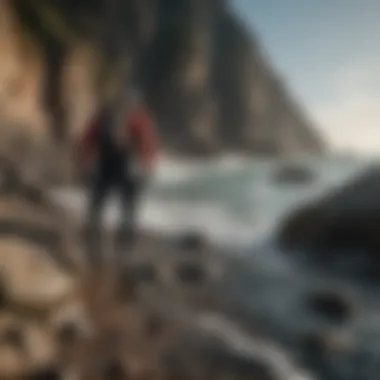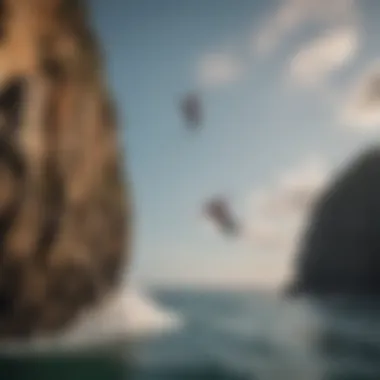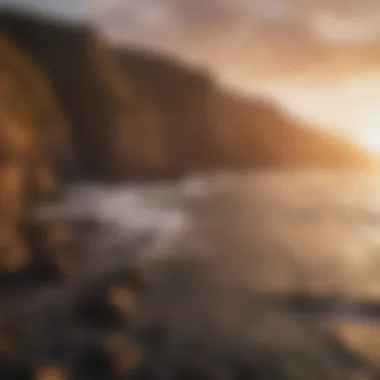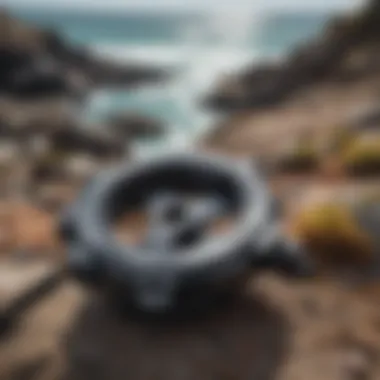Coasteering in Ireland: An In-Depth Exploration


Intro
Coasteering in Ireland is more than just an adrenaline-filled activity; it’s a immersive experience that combines adventure with the explore nature's beauty. Participants navigate rocky coastlines by swimming, climbing, and jumping into the wild waters below. This thrilling sport is increasingly gaining popularity, attracting both the seasoned adventure seekers and those who simply want to experience Ireland in a unique way.
The coastlines of Ireland are diverse, offering various challenges and stunning views, from steep cliffs to rugged rocks, making it an ideal playground for coasteering. Specific locations like Donegal and the Wild Atlantic Way are renowned for their breathtaking scenery and excellent conditions. Understanding the nuances of the sport, including essential gear, safety measures, and proper techniques, is vital for anyone looking to immerse themselves in coasteering. This article will guide you through these aspects, ensuring a safe yet exhilarating experience.
Equipment and Gear
Overview of Essential Gear for Coasteering
To embark on a coasteering adventure, having the right equipment is paramount. Essential items include:
- Wetsuit: A good wetsuit is vital as it provides thermal insulation. The thickness required may depend on the water temperature during the season.
- Helmet: Protecting your head from rocks and obstacles is crucial, and wearing a well-fitted helmet is not optional.
- Footwear: Sturdy and nonslip shoes are necessary to prevent slipping on wet rocks.
- Buoyancy Aids: These help keep participants afloat and are essential, especially in rough waters.
Detailed Descriptions of Top Brands and Recommended Products
Certain brands stand out when it comes to coasteering equipment. For wetsuits, O’Neill is known for their superior thermal quality. When it comes to helmets, Petzl offers reliability and durability, perfect for protecting against impacts. For footwear, Salomon provides shoes designed specifically for wet and rocky environments, ensuring safety and grip.
Tips on Maintenance and Upgrades
Proper maintenance of gear extends its lifespan. Rinse gear with fresh water after use, especially wetsuits. Inspect helmets regularly for cracks or damages. Upgrade gear periodically to keep up with advancements in technology, such as lighter materials or improved insulation.
Techniques and Training
Breakdown of Advanced Skills for Coasteering
Mastering coasteering involves honing various skills. Participants should be proficient in swimming, climbing, and jumping. Learning how to read the sea conditions is also essential. Understanding tidal patterns and currents can significantly enhance safety.
Training Exercises and Routines
To prepare for the physical demands of coasteering, consider workouts focusing on:
- Strength Training: Bodyweight exercises like push-ups, pull-ups, and squats can build essential muscle endurance.
- Agility Drills: Ladder drills or cone exercises can improve footwork and agility.
- Endurance Activities: Include swimming laps or running to enhance cardiovascular fitness.
Insight from Professionals
Learning from experienced coasteerers or trainers can improve your skills. Many professionals recommend attending workshops or courses, which provide valuable techniques and safety tips that are not found in standard training manuals.
Safety and Risk Management
Importance of Safety Protocols
Safety should always be the foremost concern in any extreme sport, including coasteering. Establish strict protocols before venturing out. Ensure that everyone in your group is aware of the potential dangers.
Common Risks and Potential Hazards
The most common risks associated with coasteering involve:
- Slips and falls on wet rocks.
- Hypothermia from exposure in cooler water.
- Injuries from jumping into unpredictable surf conditions.
Strategies for Risk Mitigation
To mitigate these risks, follow these guidelines:
- Stay Informed: Always check weather and tide conditions before heading out.
- Group Cohesion: Maintain close communication with group members.
- Emergency Preparedness: Carry a first aid kit and know the location of the nearest medical help.


Epilogue
Coasteering in Ireland offers a unique blend of adventure and the beauty of nature. It's a sport that requires preparation, dedication, and respect for the environment. By selecting the right equipment, mastering essential techniques, and prioritizing safety, you can fully experience the thrill that coasteering has to offer. This engaging activity not only brings about personal growth but also promotes a deep appreciation for the stunning Irish coastlines.
Prologue to Coasteering
Coasteering represents a thrilling mix of adventure, exploration, and natural beauty. It invites participants to traverse rugged shorelines, swim through coastal waters, and jump from cliffs into the ocean. This section sets the foundation for understanding coasteering's significance not only as a sport but also as a means of connecting with Ireland's stunning coastlines.
Definition and Origins
Coasteering can be defined as an outdoor activity that involves navigating along the intertidal zone, which is the area between high and low tide. It combines swimming, climbing, and jumping, making it a unique all-in-one experience. The origins of coasteering are somewhat unclear; however, it is widely accepted that this activity emerged in the United Kingdom during the late 1980s and early 1990s as a way for adventure seekers to explore coastal areas. Over time, it gained popularity and found its way to various coastal regions around the world, including Ireland. The country's rugged cliffs and picturesque coastlines make it an ideal destination for coasteering enthusiasts.
Growing Popularity in Extreme Sports
The rise of extreme sports has brought coasteering into the spotlight. This surge in interest can be attributed to several factors. First, the adrenaline rush associated with jumping off cliffs and navigating choppy waters resonates with those seeking new challenges. Secondly, the accessibility of coastal areas in Ireland provides ample opportunity for adventurers to engage in this activity without extensive travel. Finally, social media has played a significant role in showcasing stunning visuals of coasteering experiences, inspiring many to participate.
As interest in extreme sports continues to grow, coasteering stands out because of its blend of physical challenge and natural beauty. It embodies a spirit of exploration, encouraging individuals not just to push their limits, but also to appreciate the coastal environments they are traversing. With its ever-expanding popularity, coasteering in Ireland represents an exciting frontier for those eager to immerse themselves in adventure.
The Appeal of Coasteering in Ireland
Coasteering in Ireland combines the thrill of adventure with the beauty of nature, making it an exciting activity for many. This section will explore its appeal through the lens of stunning coastal landscapes and the inherent adventure it offers.
Stunning Coastal Landscapes
The geographical features of Ireland present a unique backdrop for coasteering. The rugged cliffs, hidden coves, and turquoise waters of the coastline invite adrenaline-seekers to engage in a multi-dimensional experience that goes beyond mere physical exertion. Locations such as the Wild Atlantic Way provide breathtaking views that enhance the excitement of navigating through rocky terrain while exploring tidal pools and marine life.
The diverse ecosystems along the coast showcase Ireland's natural beauty. As participants traverse through these landscapes, they encounter various flora and fauna, contributing to a sense of engagement with the environment. The changing tides also create a dynamic environment, allowing coasteering experiences to differ significantly from one day to another, ensuring that even seasoned adventurers find something new and captivating each time.
Adventure and Exploration
Coasteering is not just about the thrill of the jump or the rush of the waves. It also represents an opportunity for exploration. Participants can challenge their limits while discovering new coastal paths, unique rock formations, and secluded beaches that are often inaccessible by traditional means.
Engagement with these environments fosters a deeper appreciation for nature. The activity promotes not just individual challenges but also team-building opportunities. Excursions typically involve groups, encouraging teamwork as participants guide each other through obstacles. Such shared experiences often lead to lasting connections and shared memories.
In summary, the appeal of coasteering in Ireland hinges on the striking coastal landscapes and the multifaceted adventure that piques interest among athletes and adventure seekers. As participants engage with nature in a thrilling manner, they also foster deeper connections to the environment and to each other.
Essential Gear for Coasteering
In the sport of coasteering, the right equipment is crucial. It not only enhances the experience but also ensures safety. Coasteering involves scrambling along rocky coastlines, swimming in the open sea, and sometimes jumping off cliffs into the water. Thus, the gear used must be suitable for these activities. Participants should understand that investing in high-quality gear can elevate safety and comfort.
Clothing Requirements
The choice of clothing in coasteering should balance comfort and protection. Wetsuits are often essential since they provide insulation in cold waters and protect the skin from abrasions. A well-fitted wetsuit allows for ease of movement. A thickness of 3mm to 5mm is usually recommended for coastal activities in Ireland, depending on the season.
It is also advisable to wear rash guards under the wetsuit. They offer additional protection against irritations caused by the wetsuit. Plus, they also add a layer of warmth. Footwear is another significant consideration. Water shoes with a strong grip will help maintain stability on slippery rocks. Participants should avoid wearing flip-flops or sandals, as they can easily be lost in rough waters.
Safety Equipment
Safety should be a top priority in coasteering. Important safety gear includes helmets, buoyancy aids, and personal flotation devices. Helmets protect against head injuries from falling rocks or during climbs. Buoyancy aids help keep the individual afloat and provide additional thermal protection.
Utilizing a life jacket is also recommended, especially for those less confident in swimming. It can improve comfort and confidence in the water. Each participant should ensure their gear is properly fitted and comfortable. Performing checks before each outing helps confirm that equipment is in good working condition.
Recommended Accessories
To maximize safety and enjoyment, several accessories should be considered. A waterproof bag for storing personal items is useful, especially for mobile phones and cameras. In addition, a first aid kit should always be on hand during coasteering trips. This can aid in addressing minor injuries that may occur during the activity.
Also, consider using a whistle or signaling device. It can be an essential tool for communicating during group activities. Another smart addition is a map or GPS device for navigation. Like any sport, preparation is vital for a successful coasteering adventure. Hence, being equipped with proper accessories ensures readiness for unexpected situations.


"Safety is not just paramount; it is indispensable in ensuring that coasteering remains an enjoyable experience."
In summary, the essential gear for coasteering encompasses appropriate clothing, safety equipment, and thoughtful accessories. Ensuring that each element is suitable and well-maintained allows participants to immerse fully in the thrill of this unique adventure sport.
Safety Considerations
Understanding the safety considerations involved in coasteering is crucial for anyone engaging in this adventurous sport. While coasteering offers exceptional thrills and stunning views, it inherently comes with risks that require careful attention and preparation. Participants, whether seasoned adventurers or novices, must prioritize safety to ensure their experience is enjoyable without unnecessary hazards.
Risks Involved in Coasteering
Coasteering, by its nature, exposes individuals to various risks. Understanding these risks is the first step in mitigating them. Common dangers include:
- Slippery surfaces: Rocky shorelines can be treacherous. The presence of seaweed and algae can make footing unstable, leading to slips and falls.
- Strong currents: Coastal waters may harbor strong riptides or currents that can swiftly carry individuals away from safety.
- Unexpected waves: Classes of waves can suddenly increase due to changing weather conditions, posing a threat while jumping or swimming.
- Sharp rocks and marine life: Hidden sharp edges or organisms such as sea urchins can result in injuries if stepped on carelessly.
Awareness of these risks is essential. Participants should assess environmental conditions before the activity and make informed decisions to proceed safely.
Emergency Procedures
Despite the best precautions, emergencies can still occur in coasteering. It's crucial to have a clear plan for handling such situations. Here are steps to follow in case of emergencies:
- Stay Calm: Keeping a clear mind helps assess the situation effectively.
- Signal for Help: If in a group, signal others, or use any available communication device to alert rescuers.
- Practice Basic First Aid: Knowing how to apply pressure to wounds or perform CPR can save lives. Pre-participation training can be beneficial in this regard.
- Know Your Exits: Familiarize yourself with escape routes and nearby safe zones before starting the adventure.
- Use Personal Flotation Devices: Always wear life jackets in turbulent water. They provide buoyancy and improve survival chances.
Remember, knowing how to react in emergencies can greatly influence outcomes and enhance safety in this exhilarating sport.
Guidelines for Safe Practice
To ensure safety during coasteering, following established guidelines is essential. Here are strategies and practices to promote safety:
- Choose Experienced Guides: Joining a guided tour is beneficial. Experienced guides understand local conditions and provide crucial safety tips.
- Pre-activity Briefing: Ensure a thorough briefing on safety practices takes place before embarking on the adventure. Discussion should include terrain, potential hazards, and emergency protocols.
- Use Appropriate Gear: Wearing a wetsuit can help protect against cuts and cold water. Helmets are recommended to shield the head from sudden impacts.
- Follow Group Dynamics: Stay with the group and maintain communication. Do not wander off on your own.
- Avoid Alcohol Consumption Prior: It is vital to remain sober while taking part in coasteering. Alcohol can impair judgment and reaction times.
By adhering to these guidelines, participants can enjoy the thrill of coasteering while minimizing risks.
Top Coasteering Locations in Ireland
Coasteering provides an adrenaline-fueled adventure while allowing enthusiasts to appreciate the stunning coastlines of Ireland. Identifying prime locations to engage in this activity is essential. Different areas offer unique experiences shaped by geographical features, available routes, and water conditions. Participants should consider not only the thrill that each site provides but also the environmental impact and safety aspects involved in coasteering.
Wild Atlantic Way
The Wild Atlantic Way stands as a beacon for adventure seekers. This scenic route spans over 2,500 kilometers, showcasing some of the most spectacular coastal landscapes in the world. For coasteering, locations along this stretch, such as the Cliffs of Moher and the rock formations at Downpatrick Head, are particularly notable.
The coastline here presents numerous challenges, from rocky outcrops to crashing waves, creating an exhilarating environment for participants. The varied terrain supports both beginners and experienced coasteerers, making it an attractive spot for groups or individuals looking for thrill and beauty.
Additionally, the proximity to local guides enhances safety and ensures a deeper understanding of the environment. Proper guidance can help mitigate risks while maximizing enjoyment. The combination of stunning views and adventure creates an unforgettable experience for those exploring the Wild Atlantic Way.
County Antrim
County Antrim is another popular destination for coasteering, specifically known for its dramatic cliffs and unique geological features. The iconic Giant's Causeway offers a fascinating backdrop. The basalt columns provide not just a stunning visual but also a challenging landscape for adventurers.
Moreover, locations such as Ballintoy Harbour attract coasteerers with their rugged beauty and diverse marine wildlife. Here, participants have the opportunity to navigate through tidal pools and alongside cliff faces. This intimate interaction with nature enhances the experience.
Environmental consideration is crucial in this area. Efforts to reduce human impact on local ecosystems are vital to preserving its natural beauty. Participants should practice Leave No Trace principles to protect the habitats that contribute to the allure of County Antrim.
County Kerry
County Kerry boasts some of the most breathtaking views and vaired coastlines, ideal for coasteering enthusiasts. The Skellig Islands are a notable highlight, with steep cliffs and challenging waters. Skellig Michael, a UNESCO World Heritage Site, offers dramatic drops into the Atlantic, combining adventure and history.


The beaches in County Kerry, particularly those near Dingle Peninsula, also present safe entry points for coasteering. The vibrant marine life and clear waters provide a perfect setting for both exploration and leisure.
Additionally, local operators prioritize environmental sustainability. Engaging with guides who focus on leaving the smallest carbon footprint enriches the experience for coasteerers. Their commitment to eco-friendly practices allows adventurers to enjoy the thrill while respecting the delicate ecosystems in place.
"Coasteering locations in Ireland not only provide thrill but also a chance to foster appreciation for the rich coastal environment."
Identifying and understanding these top coasteering locations is essential for providing an enriching adventure that balances excitement with environmental awareness.
Environmental Considerations
Environmental considerations play a crucial role in ensuring that coasteering activities do not adversely affect Ireland's unique coastal ecosystems. As coasteering gains popularity among adventure enthusiasts, it becomes increasingly important to assess its ecological impact, as well as to implement sustainable practices to protect these natural resources. Understanding the delicate balance between thrill-seeking and environmental preservation is vital for the long-term viability of this sport.
Impact on Local Ecosystems
Coasteering involves navigating rocky coastlines, jumping into waters, and exploring diverse marine environments. These activities can disrupt local ecosystems if not managed properly.
- Terrestrial Impact: Roaming along the shore can lead to trampling of sensitive flora and fauna. This is especially concerning in areas where plant life is already stressed.
- Marine Impact: Splashing and swimming could potentially disturb marine wildlife, particularly during breeding seasons. Species like seals and various seabirds may feel threatened and change their behavior because of human activity.
To mitigate these impacts, coasteering participants should be informed about local ecosystems and adhere to guidelines provided by environmental organizations. Respecting wildlife habitats is not just about protecting species; it is also about ensuring that coasteering remains a viable activity for the future.
Sustainable Practices
Implementing sustainable practices in coasteering is essential to minimize its ecological footprint. Adventure companies and participants alike can contribute positively to the environment through various initiatives:
- Leave No Trace: This principle emphasizes minimizing your footprint by packing out everything you bring and avoiding disturbances to natural habitats.
- Guided Tours: Opting for guided coasteering experiences ensures that knowledgeable individuals lead the way, educating participants about the environment along the journey. Guides can also assess conditions better than individuals may on their own.
- Adhering to Local Regulations: Different regions may have specific rules regarding wildlife safe zones and restricted areas. Following these is critical to protecting vulnerable species from undue stress.
By integrating these practices into the adventure sports culture, not only do we safeguard our natural surroundings, but we also enhance the overall coasteering experience for future generations. The responsibility lies with both participants and companies to ensure that the excitement of coasteering does not come at the expense of the rich biodiversity that defines Ireland's coastline.
"Sustainable practices are the bridge between adventure and preservation, ensuring both thrill and tranquility for the future."
Emphasizing education and awareness can greatly enhance the impact individuals have, making coasteering not just a sport, but a commitment to nature's preservation.
Coasteering as a Skill Development Activity
Coasteering serves as more than just an adrenaline-filled activity along the rugged coastlines of Ireland. It acts as a transformative experience that aids in skill development both physically and mentally. Engaging in coasteering can cultivate essential skills, enhance fitness, and foster teamwork and trust. Recognizing these elements is crucial for those who partake in this adventure, allowing them to appreciate its broader benefits.
Physical Fitness Requirements
Participating in coasteering demands a significant level of physical fitness. It requires a combination of strength, endurance, and agility.
- Strength: Upper body strength is critical for climbing, while lower body strength enhances jumping and swimming capabilities.
- Endurance: Coasteering can often involve extended periods of activity. Good cardiovascular fitness is necessary to sustain energy throughout the adventure.
- Agility: Navigating rugged terrains and dealing with slippery surfaces calls for quick reflexes and coordinated movements.
A well-rounded fitness regime, including cardiovascular exercises, strength training, and flexibility workouts, can prepare individuals for the physical challenges of coasteering. A focused training approach not only enhances personal performance but also minimizes the risk of injury during the activity.
Building Teamwork and Trust
Coasteering often requires groups to work closely together, creating an environment conducive to building teamwork and trust. The following aspects illustrate the importance of these qualities:
- Collaboration: Successfully navigating challenging sections of a coastline often requires clear communication and support among team members. Coasteering fosters a sense of unity as participants rely on each other's strengths to overcome obstacles.
- Trust Building: Trust is essential, particularly in activities that involve risk. Participants learn to trust their teammates’ abilities and decisions, which enhances the overall experience and safety of the group.
- Leadership Opportunities: Coasteering allows individuals to take on various roles, whether guiding others or being guided. This dynamic helps individuals grow in leadership and followership, both of which are valuable in everyday life.
Epilogue
Coasteering in Ireland represents a unique blend of adventure, exploration, and respect for nature. This article has traversed various facets of coasteering, emphasizing not only the thrilling experiences it offers but also the responsibility that comes with engaging in such activities.
Summary of Key Points
- Definition and Origins: Coasteering began as a method of exploring the coastline and has grown into a popular sport.
- The Appeal in Ireland: The country's stunning landscapes make it a prime location for coasteering, attracting both thrill-seekers and nature lovers.
- Essential Gear: Proper clothing and safety equipment are crucial for a safe experience during coasteering.
- Safety Considerations: Understanding risks and following guidelines is imperative for a positive experience.
- Top Locations: The Wild Atlantic Way, County Antrim, and County Kerry are standout areas for coasteering in Ireland.
- Environmental Impact: Participants must acknowledge their impact on ecosystems and practice sustainability.
- Skill Development: Coasteering fosters physical fitness and can enhance teamwork and trust amongst participants.
- Future Outlook: Strong interest in outdoor activities suggests a bright future for coasteering, provided environmental considerations are prioritized.
Future Outlook for Coasteering in Ireland
The future of coasteering in Ireland looks promising due to a growing interest in outdoor adventure sports. As more people seek unique experiences, coasteering can be a top choice. But this rise in popularity comes with a responsibility to protect natural habitats.
Plans for sustainable practices can help ensure that coasteering remains a viable activity for years to come. Local organizations and instructors can offer programs focusing on environmental awareness, ensuring that all participants appreciate the fragile ecosystems they traverse. This dual approach of adventure and conservation can create a novel niche within the outdoor sports community, attracting not only adventurers but also those interested in ecology.













